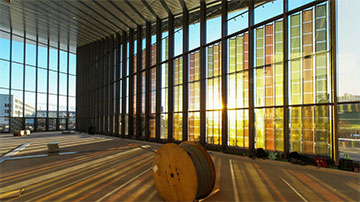
Dye-sensitized solar cells installed at EPFL’s SwissTech Convention Center in Switzerland. The cells owe their energy-harvesting abilities to dye molecules adsorbed onto the surface of semiconductor nanoparticles. Now researchers at the EPFL have shown how to boost the efficiency of cells with two complementary dye molecules by adsorbing a third type of molecule, before the two dyes, onto the nanoparticles. [Image: A. Herzog]
Dye-sensitized solar cells are transparent devices that can be made cheaply and operate at various wavelengths, having already been deployed in settings such as building facades and greenhouses. However, they remain less efficient than other types of thin-film solar cells.
Now scientists in Switzerland have shown how to boost the efficiency of such cells by making them from two dyes sensitive to different parts of the electromagnetic spectrum, which the researchers were able to do by attaching the dyes to a third molecular species covering the underlying nanoparticles (Nature, doi: 10.1038/s41586-022-05460-z). The researchers found they could convert around 15% of sunlight into electricity using the new setup while boosting the conversion of ambient light to around 30%.
Importance of dye molecules
Chemists Michael Grätzel and Brian O’Regan invented dye-sensitized solar cells in the early 1990s after showing that electrons excited by light in certain types of dye molecule could be used to generate an electric current by attaching, or “adsorbing,” the molecules onto an array of semiconductor nanoparticles. The electrons flow into the semiconductor’s conduction band, travel to power a battery or other load, and pass through an electrolyte and back into the dye.
The innovation exploited the fact that the nanoparticles, usually made from titanium dioxide, increase the surface area to which the tiny dye molecules, or “sensitizers,” can be attached—thereby increasing the amount of light harvested by a device of a given size. The challenge then was to establish which kind of dye molecules would maximize efficiency. Two or more sensitizers can be combined to broaden the absorption spectrum of the solar cells, but finding the right combination requires a long, drawn-out process of design and chemical synthesis.
The third molecule boosts efficiencies
In the latest work, a group at the EPFL, Switzerland, led by Grätzel and Anders Hagfeldt (now at Uppsala University, Sweden) has studied the electricity-generating capabilities of two particular organic dyes—one absorbing best in the middle of the visible spectrum and the other at blue wavelengths. But the researchers also included an additional ingredient: a single layer of a hydroxamic acid derivative, which they adsorbed on to the titanium dioxide nanoparticles before the dye molecules.
Grätzel, Hagfeldt and colleagues found that, without covering the nanoparticles using this extra type of molecule, the sensitizers initially adsorb quickly. But not long afterward, the short-wavelength dye starts to become detached, and the overall molecular assembly is less dense and more disordered than it would be with just a single type of dye molecule. In contrast, by first putting down the hydroxamic acid, the initial adsorption of the dyes is delayed, but the final result is better—boosting the molecular density and uniformity.
With their new dye-sensitized scheme, the researchers found they were able to convert 15.2% of simulated solar energy into electricity when employing the extra fabrication step, compared with 14.4% without it—an improvement confirmed by an independent lab in Switzerland. They also recorded an efficiency boost with ambient artificial light, measuring about 30% when illuminating a solar cell using a light-emitting diode versus about 27% without the additional layer. The LED yields higher efficiencies because it emits entirely in the visible spectrum, while the sun emits about half of its photon flux at infrared wavelengths.
Future applications
The researchers suggest that the latter result holds particular promise for applications associated with the Internet of Things (IoT). They note that speedy growth of the IoT would result in billions of new wireless sensors being installed within buildings over the next few years. With that, the researchers argue, dye-sensitized solar cells would be well-suited as a power source; the cells’ efficient operation in ambient light, the team suggests, would offer a promising alternative to batteries, which have limited lifespans and need to be regularly recharged.
Grätzel says that getting to higher efficiencies—perhaps beyond 20% for sunlight—could be reached through “judicious molecular design of the sensitizers.”
